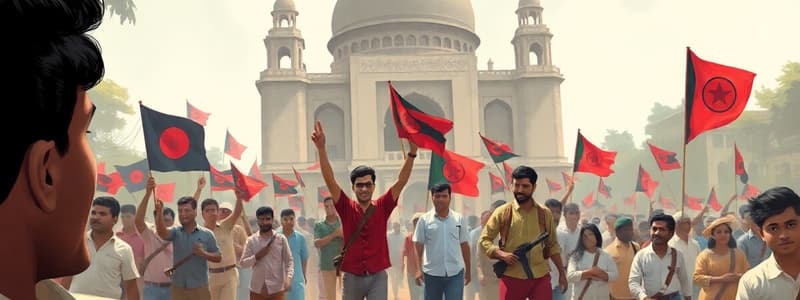Podcast
Questions and Answers
Sheikh Hasina was ousted from her position as Prime Minister after a peaceful protest movement.
Sheikh Hasina was ousted from her position as Prime Minister after a peaceful protest movement.
False (B)
Muhammad Yunus, an interim leader, previously won the Nobel Peace Prize.
Muhammad Yunus, an interim leader, previously won the Nobel Peace Prize.
True (A)
The protests in Bangladesh were primarily led by high school students.
The protests in Bangladesh were primarily led by high school students.
False (B)
Sheikh Mujibur Rahman was Bangladesh's first President after independence.
Sheikh Mujibur Rahman was Bangladesh's first President after independence.
Bangladesh gained independence from Pakistan in 1971 after a peaceful negotiation process.
Bangladesh gained independence from Pakistan in 1971 after a peaceful negotiation process.
Sheikh Mujibur Rahman introduced a quota system for jobs in Bangladesh post-independence to benefit liberation fighters.
Sheikh Mujibur Rahman introduced a quota system for jobs in Bangladesh post-independence to benefit liberation fighters.
Muhammad Yunus was the first winner of the Nobel Peace Prize in Bangladesh.
Muhammad Yunus was the first winner of the Nobel Peace Prize in Bangladesh.
The Bangladesh Nationalist Party emerged as a direct continuation of the Awami League's policies after the independence movement.
The Bangladesh Nationalist Party emerged as a direct continuation of the Awami League's policies after the independence movement.
Inflation became a significant issue in Bangladesh despite economic growth attributed to foreign financial support.
Inflation became a significant issue in Bangladesh despite economic growth attributed to foreign financial support.
The interim government in Bangladesh has completely banned the Awami League from participating in future elections.
The interim government in Bangladesh has completely banned the Awami League from participating in future elections.
The population of Hindus in Bangladesh has decreased from thirty percent to around eight percent.
The population of Hindus in Bangladesh has decreased from thirty percent to around eight percent.
After the military government period from 1975 to 1990, the quota system for jobs was promptly re-implemented without any legal challenges.
After the military government period from 1975 to 1990, the quota system for jobs was promptly re-implemented without any legal challenges.
Students were the primary opposition group against Sheikh Hasina's government during the recent uprisings.
Students were the primary opposition group against Sheikh Hasina's government during the recent uprisings.
Sheikh Hasina's government has received widespread support from the Pakistani Army during recent upheaval in Bangladesh.
Sheikh Hasina's government has received widespread support from the Pakistani Army during recent upheaval in Bangladesh.
Yunus's efforts in creating a political party were welcomed by Sheikh Hasina, who wanted to collaborate with him.
Yunus's efforts in creating a political party were welcomed by Sheikh Hasina, who wanted to collaborate with him.
Flashcards are hidden until you start studying
Study Notes
Overview of Recent Events in Bangladesh
- Prime Minister Sheikh Hasina of Bangladesh resigned and fled to India amid mass protests against her authoritarian regime.
- Protests, primarily led by college students, escalated in July, resulting in over three hundred deaths and thousands of arrests.
- The military withdrew support for Hasina, leading to an interim government formed under Muhammad Yunus, a Nobel Peace Prize-winning economist.
Historical Context
- Bangladesh gained independence from Pakistan in 1971 after a brutal war that resulted in mass killings.
- Sheikh Mujibur Rahman, Hasina’s father, was a key figure in the independence movement, later becoming the first Prime Minister and President of Bangladesh.
- Hasina has ruled for fifteen years, previously holding office in the 1990s.
Breakdown of Political Dynamics
- Hasina’s rule characterized by significant foreign debt, particularly to China and Japan, which funded infrastructure projects amid widespread corruption.
- Inflation and unemployment issues contributed to public unrest, particularly among students affected by changes to civil service job quotas linked to liberation fighters.
Role of Quota System
- The original job quota system for descendants of liberation fighters was created in 1972, but was inconsistently implemented during military rule from 1975 to 1990.
- Recent court rulings influenced student protests after the reversal of scrapping quotas, resulting in violent clashes with police.
Historical Political Rivalry
- The Awami League (led by Hasina) and the Bangladesh Nationalist Party (BNP) emerged from the aftermath of independence, with distinct ideological positions.
- Awami League emphasized nationalism, socialism, democracy, and secularism; BNP was seen as aligned with pro-Pakistani elements and adopted a more Islamist stance.
- Political tensions between the two parties have resulted in ongoing authoritarian practices and oppression of dissent.
Threats to Minorities
- Historical context of violence against Hindus during political upheaval; Hindus currently make up about 8% of the population, down from 30%.
- Recent fears of targeted violence against Hindus due to perceived connections between Hasina’s regime and the Hindu-nationalist BJP government in India.
Muhammad Yunus and His Influence
- Yunus is credited with founding Grameen Bank and an iconic figure in microfinance, aimed at poverty alleviation.
- His political ambitions in 2007 led to tensions with Hasina, resulting in a significant rift.
- The interim government includes students and civil society leaders seeking a democratic alternative to the existing political dynamics.
Future Prospects
- The interim government, under Yunus, is framed as a caretaker administration intending to re-establish democracy and reform state institutions.
- Yunus is viewed as a potential unifying figure, with parallels drawn to Nelson Mandela in terms of providing leadership during a crucial transitional period.
- Challenges remain regarding the stability and effectiveness of reforms aimed at preventing future authoritarianism in Bangladesh.
Studying That Suits You
Use AI to generate personalized quizzes and flashcards to suit your learning preferences.




